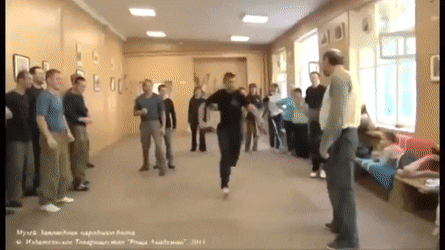Utilizing physics in teaching is useful for those who must see a representation of what they are being told or they hear. Some people do not have to have concepts drawn, they can visualize it. Some people have to have it drawn on a board and explained. Once in a seminar I was speaking about catching a strike and turning it into a throw, and I gave the example of a tangent – drew the diagrams and I demonstrated what was happening when that occurs. Some of the students found it fascinating and as I explained various angles. When I go to how the angle of attack meant little due to the rotation, they became more impressed.
Yea, I know, exciting stuff – riveting, right? We slowed training down slightly so people would use the rotation and continued on in training phases.
They quickly found that the tangent example was a visualization and a theoretical principle meant to help them, but was not a be all/end all in training because with full force it did not always accomplish the task.
It was training wheels, not the bike. It’s a complex movement and theory…I thought they understood.
A few months later I was in town and stopped by the school and they were drawing very complex physics equations on a white board and had slowed training down to a relative crawl. They were no longer concerned with realism – they were concerned with complexity of physics and mechanics and how what they were doing appeared. They were becoming great at demos, just check it out, they said, this stuff works!
Plus they told me they had bought a lot of videos from Russia.
In their minds they were very advanced. It always worked in training! In reality, they were becoming absolutely worthless as fighters and were one step above a stage combat group in realism.

They had adapted their training to the physics, instead of the physics to their training.
They were not training and learning, they were not testing and adjusting.
They were taking physics concepts and making their training a pure reflection of those concepts without the temperance of realism.
Combined with videos from overseas and other systems, what was happening was all too recognizable. They were becoming demo artists, not martial artists.
This happens often in the more scientific styles as people begin to overanalyze. They see the lethality when performing at 25% and they look impressive when they do it. Usually this is done against completely compliant fellow students and they begin to forget why they are studying: survival.
I corrected the situation and things went back to normal, but it took very hard methods I don’t like to use on my part, and a lot of redirecting the focus of the training using the CLM to make this alteration and valuable time was lost. Valuable neurological ‘space’ was taken up with drills and applications that made little sense outside of creating positive feedback for the ego.
Now they had to overwrite in their neurology what they had done. That takes time.
Many times this happens in arts and people and the giant fat line between ‘Let’s go slow so we can explore this’ and ‘We train slow because if we go fast we may injure each other’ gets blurred.
One must be careful to know the line between analysis and over-analyzing, lest paralysis take hold.
At a certain point a punch is a punch and a kick is still a kick, despite the physics and concepts behind them.
When the reality of what a punch and a kick are is replaced by a thought process that overcomplicates them, we forget what they will actually do to someone and how unpredictable they are in use and affect.
We must never forget the human element of martial art that is governed by adaptation and people not doing what they should do. Here’s a few tips to avoid this if you break out the white board and diagram:
1. If it doesn’t work three times in a row against a partner giving tension, it should not be repeated again. Move to something that works so you don’t lose training time and come back to it at another date.
2. If it looks too good to be true – in actual combat – it probably is. Real life has a way of proving this. Better to have it proved in the training room than proved in the hospital.
3. If you are spending more than 20% of your time with diagrams, you are not training properly. Remember – theory + movement = application. 20/30/50 is a good rule of thumb to decide how much time in a class to devote to each part of the Pramek equation. Drawing it out isn’t the same as doing it.

4. Demonstrations on video are just that – demonstrations. They are another person working in another environment for a different purpose. Focus on what you have in real life in your training room and leave the special stunts to the videos.
5. Lastly, don’t theorize….do it and test your theory.
Train smart…!
Matt

